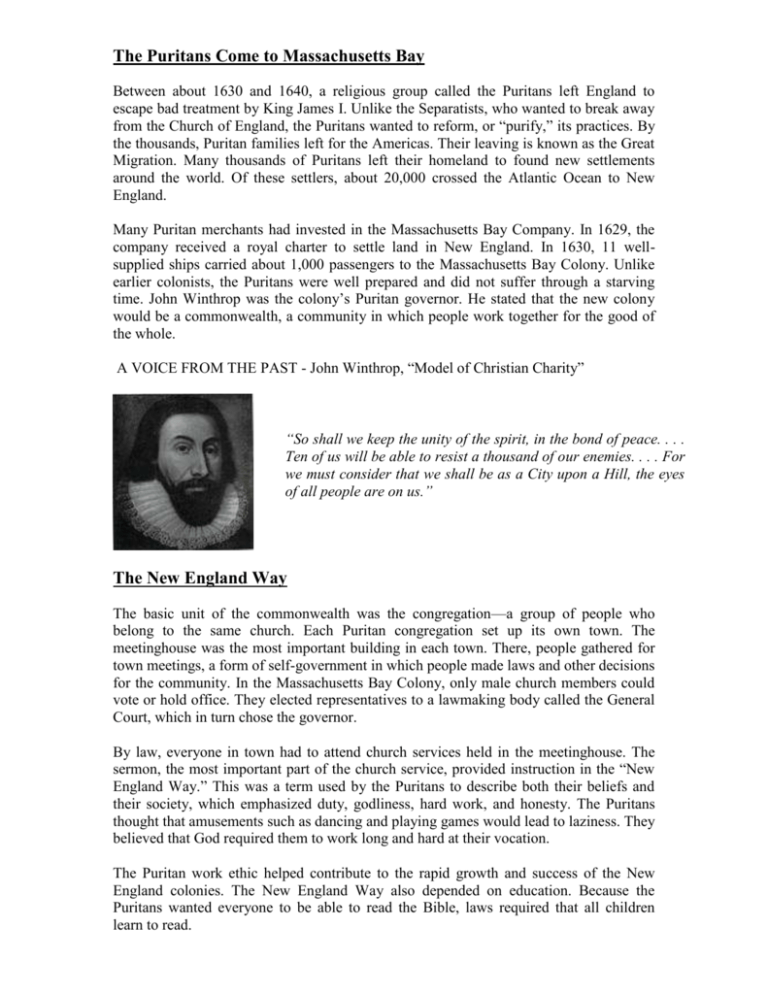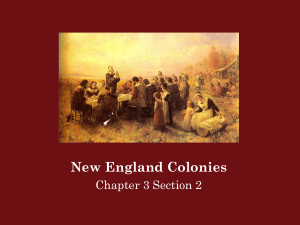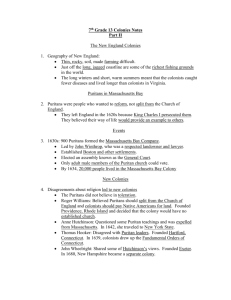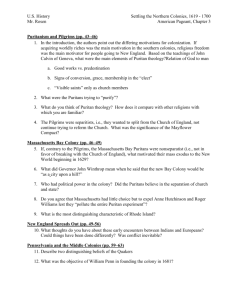Massachusetts Bay Colony
advertisement

The Puritans Come to Massachusetts Bay Between about 1630 and 1640, a religious group called the Puritans left England to escape bad treatment by King James I. Unlike the Separatists, who wanted to break away from the Church of England, the Puritans wanted to reform, or “purify,” its practices. By the thousands, Puritan families left for the Americas. Their leaving is known as the Great Migration. Many thousands of Puritans left their homeland to found new settlements around the world. Of these settlers, about 20,000 crossed the Atlantic Ocean to New England. Many Puritan merchants had invested in the Massachusetts Bay Company. In 1629, the company received a royal charter to settle land in New England. In 1630, 11 wellsupplied ships carried about 1,000 passengers to the Massachusetts Bay Colony. Unlike earlier colonists, the Puritans were well prepared and did not suffer through a starving time. John Winthrop was the colony’s Puritan governor. He stated that the new colony would be a commonwealth, a community in which people work together for the good of the whole. A VOICE FROM THE PAST - John Winthrop, “Model of Christian Charity” “So shall we keep the unity of the spirit, in the bond of peace. . . . Ten of us will be able to resist a thousand of our enemies. . . . For we must consider that we shall be as a City upon a Hill, the eyes of all people are on us.” The New England Way The basic unit of the commonwealth was the congregation—a group of people who belong to the same church. Each Puritan congregation set up its own town. The meetinghouse was the most important building in each town. There, people gathered for town meetings, a form of self-government in which people made laws and other decisions for the community. In the Massachusetts Bay Colony, only male church members could vote or hold office. They elected representatives to a lawmaking body called the General Court, which in turn chose the governor. By law, everyone in town had to attend church services held in the meetinghouse. The sermon, the most important part of the church service, provided instruction in the “New England Way.” This was a term used by the Puritans to describe both their beliefs and their society, which emphasized duty, godliness, hard work, and honesty. The Puritans thought that amusements such as dancing and playing games would lead to laziness. They believed that God required them to work long and hard at their vocation. The Puritan work ethic helped contribute to the rapid growth and success of the New England colonies. The New England Way also depended on education. Because the Puritans wanted everyone to be able to read the Bible, laws required that all children learn to read. Some Puritan congregations set up new colonies. In 1636, Thomas Hooker moved his congregation to the Connecticut Valley. There they wrote and adopted the Fundamental Orders of Connecticut in 1639. In effect, these laws were a constitution. The Fundamental Orders extended voting rights to non church members and limited the power of the governor. They expanded the idea of representative government. The first European settlement in New Hampshire was a village near Portsmouth in 1623. In 1638, John Wheelwright established the town of Exeter. The town’s founders drew up the Exeter Compact, which was based on the Mayflower Compact. Challenges to Puritan Leaders Not everyone agreed with the New England Way. Roger Williams was a minister in Salem, Massachusetts, who founded the first Baptist church in America. He opposed forced attendance at church. He also opposed the English colonists’ taking of Native American lands by force. Because of his beliefs, the General Court forced Williams to leave the colony. In 1636, he fled southward and founded the colony of Rhode Island, which guaranteed religious freedom and the separation of church and state. Anne Hutchinson believed that a person could worship God without the help of a church, minister, or Bible. She conducted discussions in her home that challenged church authority. Hutchinson was brought to trial and forced to leave Massachusetts. In 1638, she fled to Rhode Island. Another religious group was the Quakers. Their name came from an early leader’s statement that they should “tremble [quake] at the word of the Lord.” Opponents coined the name as an insult. Quakers challenged the Massachusetts commonwealth. They believed that each person could know God directly through “an inner light.” Neither ministers nor the Bible was needed. Quakers also believed in treating Native Americans fairly, which set them apart from other colonists. For such beliefs, Quakers were whipped, imprisoned, and hanged. Many left for Rhode Island.











